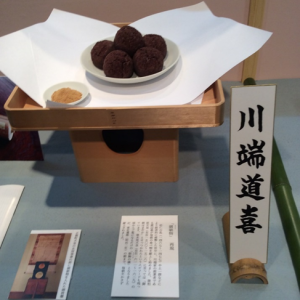Okiyobi (Purification fire) and Oasanomono (Breakfast offerings)
Yoshie Doi

Photo taken on October 29, 2014 at Hyakumikai Gion Kaburenjo
I still remember it clearly 10 years ago. I saw the real food that was presented to the Emperor every morning from before the Onin War to the Meiji Restoration. Apparently, the Emperor looked forward to the food he would eat before and after the Onin War.
There was a time when the fire from Kawabata Douki’s hearth, which was used to make these offerings, was the source of fire for Kyoto as Okiyobi (a purification fire). The following is written in the “Kawabata Douki Origin Record.”
”Since the end of the Muromachi period, the fire in the Douki family’s hearth, where the Emperor’s food was prepared, has come to be known as ‘Okiyo-bi’, a fire endowed with special meaning and dignity. Whenever there was a court ceremony or a religious service at various shrines, it was customary to bury all the fire that had been used up until then, even the ashes, in the ground and use the new fire from Douki’s hearth. The final and most important task of this event occurred on September 20th, 1852 (Kaei 5), when the 12th generation Douki Masaoki, in his third year after taking over the family business, received news of the signs of birth at the hour of the Dragon and hurriedly brought fire to boil the baby’s bath and delivered it to the Nakayama residence as instructed. This was the birth of Emperor Komei’s second son, whose childhood name was Sachinomiya, and who would later become Emperor Meiji.”
Kawabata Doukii also provided purified fire to the Imperial Palace. “On the second day of the New Year, the Imperial Palace offered three things: sake, rice cakes, and clams. The Douki family prepared these. Furthermore, the fire in the Imperial Palace needed to be purified, and new fire was provided each year from Kawabata Douki’s hearth.
At the end of the Edo period, the fire from Kawabata Douki’s oven was used to heat the well water at the Nakayama residence for the birth of Emperor Meiji.
Among the items that Kawabata Douki had presented to the Imperial Court were ashes. The “Family Mirror” states that Kawabata Douki had been purifying fire for generations, and so it was customary to use Kawabata Douki’s fire when religious ceremonies or visits to shrines were held at the Imperial Court.
The Goyo Eidaiyomonki also records orders for ashes. When Emperor Ninko (March 16, 1800 (February 21, Kansei 12)) passed away on February 21, 1846, a total of 53 bales of ashes were offered. In order to maintain the purity of the fire, Kawabata Douki would not burn anything other than firewood or brush, such as paper scraps, in the Okudosan. This custom continued until the Meiji Restoration.
The end of document
Translated by Masami Otani
